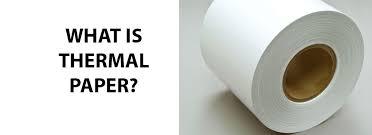Introduction
In today’s fast-paced digital and retail world, thermal paper plays a vital role in printing receipts, labels, and tickets efficiently. It is widely used in point-of-sale (POS) systems, ATMs, gas stations, and even medical equipment. Known for its quick printing process and clear results, thermal paper has become a go-to solution for businesses that require reliable and long-lasting print quality.This article explores what thermal paper is, how it works, its advantages, and the different industries that depend on it every day.
1. What Is Thermal Paper and How Does It Work?
Thermal paper is a special fine-grade paper coated with chemicals that react to heat. When it passes through a thermal printer, the printer’s heated print head activates the coating, producing images or text without the need for ink or ribbons.Unlike traditional printing that relies on cartridges, thermal printing technology simplifies the process by eliminating the need for consumables other than the paper itself. This makes it faster, cleaner, and more cost-effective.
Thermal paper typically consists of three layers:
- Base layer: The main paper sheet that gives structure and strength.
- Active layer: A chemical coating that changes color when exposed to heat.
- Protective layer: A topcoat that prevents fading, moisture damage, or scratching.
Because of these properties, thermal paper rolls are durable, efficient, and ideal for high-volume printing environments.
2. Advantages of Using Thermal Paper in Businesses
Thermal paper is not just about fast printing — it brings several practical benefits that make it a preferred choice across many industries.
- Speed and Efficiency
Thermal printers can print receipts or labels almost instantly. The absence of ink cartridges means fewer mechanical parts, resulting in faster output and minimal downtime. - High Print Quality
Prints on thermal paper rolls are sharp, clear, and smudge-free. This makes them perfect for barcode scanning and detailed text, which are essential for POS receipts, logistics labels, and healthcare documents. - Cost-Effective Solution
Since thermal printers do not use toner or ink, they save businesses ongoing costs. The only consumable needed is the paper itself, which reduces maintenance and operational expenses significantly. - Low Maintenance
Thermal printers have fewer moving parts compared to inkjet or laser printers, making them more reliable and easier to maintain. With fewer breakdowns, businesses experience smoother operations. - Eco-Friendly Options
Modern BPA-free thermal papers are now available, reducing the environmental impact. These papers are recyclable and safe for handling, aligning with eco-conscious business practices. - Versatility Across Industries
From retail stores and restaurants to logistics and medical sectors, thermal paper rolls are versatile enough to handle a wide range of printing needs such as receipts, shipping labels, prescription labels, and more.
For more related information search to pos software price in pakistan
3. Common Applications and Types of Thermal Paper
The versatility of thermal paper makes it an essential part of various industries. Let’s look at where it is most commonly used:
- Retail and Point of Sale (POS)
In retail stores, supermarkets, and restaurants, thermal paper is used for receipt printing. It offers fast output and ensures that customers get clear, durable printouts. - Banking and Finance
ATMs and credit card machines rely heavily on thermal receipt paper for quick and ink-free printing. These receipts remain readable for long periods, ensuring transaction records are reliable. - Logistics and Warehousing
Shipping labels, barcode stickers, and warehouse tags are printed using thermal label paper. The high contrast of thermal prints ensures scanners can read them accurately. - Healthcare and Laboratories
Hospitals use thermal rolls in ECG machines, ultrasound printers, and laboratory analyzers. The clarity of prints is crucial for medical accuracy. - Ticketing and Entertainment
Movie theaters, parking booths, and transportation services use thermal ticket paper for printing tickets, boarding passes, and entry slips. The fast output and fade resistance make it highly reliable.
Types of Thermal Paper:
- Top-Coated Thermal Paper: Provides better protection against moisture, UV light, and friction. Ideal for outdoor or long-term use.
- Non-Coated Thermal Paper: More affordable and suitable for short-term applications such as store receipts.
- Synthetic Thermal Paper: Made from durable plastic-based materials, offering water and tear resistance.
Conclusion
In summary, thermal paper is an essential component in modern business operations. Its speed, clarity, and cost-effectiveness make it the top choice for receipts, labels, and transaction records. Whether you run a retail shop, manage logistics, or work in healthcare, thermal paper rolls provide the reliability and efficiency your business needs.As technology evolves, thermal paper continues to improve with eco-friendly coatings and better resistance, ensuring long-lasting prints and sustainable performance. For any business that values precision and professionalism, thermal printing remains a smart investment.
For further articles visit here

